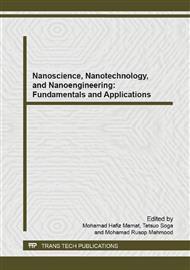[1]
Park, I., Li, Z., Pisano, A. P., & Williams, R. S. (2007). Towards The Silicon Nanowire-Based Sensor for Intracellular Biochemical Detection. Biosensors and Bioelectronics, 22, 2065-2070.
DOI: 10.1016/j.bios.2006.09.017
Google Scholar
[2]
Park, I., Li, Z., Pisano, A. P., & Williams, R. S. (2010). Top-Down Fabricated Silicon Nanowire Sensors for Real-Time Chemical Detection. Nanotechnology, 21, 1-9.
DOI: 10.1088/0957-4484/21/1/015501
Google Scholar
[3]
Grieshaber, D., MacKenzie, R., Voros, J., & Reimhult, E. (2008). Electrochemical Biosensors - Sensor Principles and Architectures. Sensors, 8(3), 1400-1458.
DOI: 10.3390/s8031400
Google Scholar
[4]
P. Bergveld, Development, Operation and Application of ISFET as a Tool for Electrophysiology, IEEE Transactions on Biomedical Engineering, Vol Bm 19, p.342, 1972.
Google Scholar
[5]
U.Hashim, Soon Weng Chong and Wei Wen Liu, Fabrication of Silicon Nitride Ion Sensitive Field- Effect Transistor for pH Measurement and DNA Immobilization/Hybridization, Journal of Nanomaterials, Volume 2013, art.no, 542737.
DOI: 10.1155/2013/542737
Google Scholar
[6]
C-H.Lin et al, Poly-silicon nanowire field-effect transistor for ultrasensitive and label-free detection of pathogenic avian influenza DNA, Biosensor and bioelectronics 24 (2009) pp.3019-3024.
DOI: 10.1016/j.bios.2009.03.014
Google Scholar
[7]
C-Y at el , Novel poly-silicon nanowire field effect transistor for biosensing application, Biosensor and Bioelectronics, 24, 2009, pp.1223-1229.
Google Scholar
[8]
NuzaihanMdNor,M., Hashim, U., Halim, N.H.A., Bajuri, S.N.M., Nanowire formation for single electron transistor using SEM based Electron Beam Lithography(EBL) technique: Positive tone vs negative tone e-beam resist, NSTI Nanotech 2006 Technical proceeding, 3,2006, pp.266-269.
Google Scholar
[9]
M.N.M. Nor, U. Hashim, N. H. A. Halim, and N. H. N. Hamat, Top‐Down Approach: Fabrication of Silicon Nanowires using Scanning Electron Microscope based Electron Beam Lithography Method and Inductively Coupled Plasma‐Reactive Ion Etching, AIP Conference Proceedings, 1217, (2010) pp.272-278.
DOI: 10.1063/1.3377829
Google Scholar
[10]
Cui, Y., Wei, Q., Park, H., Lieber, C.M., "Nanowire nanosensors for highly sensitive and selective detection of biological and chemical species," Science 293, Vol. 293 no. 5533. 2001. pp.1289-92.
DOI: 10.1126/science.1062711
Google Scholar


